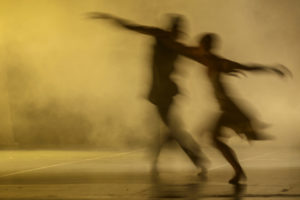In the early 20th century, before there were video cameras and smartphones, Laban recognized that dance, like music, needed a notation system to allow choreographies to be recorded. Developing a movement notation system necessitated two steps. First, the elements that make up the “alphabet of human movement” had to be identified. Secondly, symbols to represent these elements and their combinations and sequences had to be invented.

Like all good theoreticians, Laban wanted to control the number of elements so as to make his notation system as economical as possible. He had observed that “the dancer moves, not only from place to place but also from mood to mood.” This observation provided two broad categories for delineating elements of movement: “Choreutics” – where the parts of the body move in the space around the body, and “Eukinetics” – how energy is deployed as the dancer moves through space.
In delineating Choreutic and Eukinetic elements of movement, Laban’s analytic system becomes more detailed and complex. Nevertheless, Laban’s alphabet of movement requires the observer to recognize essential similarities among actions that appear rather different. As I write in Meaning in Motion, the effort quality of lightness “occurs in the tender stroking of a loved one’s cheek and in dusting crumbs off a table top – actions that seem to have little in common.” Yet they share an essential effort quality.
It can be a challenge to help college students recognize, as Laban did, that “whether the purpose of movement is work or art does not matter, for the elements are invariably the same.” But this recognition leads on to the realization that movement is a common denominator of human action. As life becomes ever more complex, isn’t it worthwhile to know this?




 correspondence course, Rebecca Nordstrom created a sequence of basic actions and imagined this movement sequence as a scenario involving the
correspondence course, Rebecca Nordstrom created a sequence of basic actions and imagined this movement sequence as a scenario involving the 

 Henri Bergson, the French philosopher, was fascinated by how analytical thinking leads us to misperceive our own experience of being alive. For Bergson, life is an unceasing, continuous, undivided process, a sort of cosmic movement. Yet, we tend to conceive our lives as passing from feeling to feeling or thought to thought, as if each is separate, unchanging thing. In reality, feelings and thoughts are themselves in a state of flux, and it is the experience of continuous changes that is central to the experience of being alive.
Henri Bergson, the French philosopher, was fascinated by how analytical thinking leads us to misperceive our own experience of being alive. For Bergson, life is an unceasing, continuous, undivided process, a sort of cosmic movement. Yet, we tend to conceive our lives as passing from feeling to feeling or thought to thought, as if each is separate, unchanging thing. In reality, feelings and thoughts are themselves in a state of flux, and it is the experience of continuous changes that is central to the experience of being alive.
 When the dancer Rudolf Laban began to study work movement in British factories, two concerns predominated. The first was efficiency; the second was fatigue. By the 1940s, of course, there were laws governing the length of the workday and providing additional protection for the health and safety of workers. Nevertheless, repetitive activity of any sort is tiring. Human beings are not machines. We cannot repeat any motion endlessly without the need for variation.
When the dancer Rudolf Laban began to study work movement in British factories, two concerns predominated. The first was efficiency; the second was fatigue. By the 1940s, of course, there were laws governing the length of the workday and providing additional protection for the health and safety of workers. Nevertheless, repetitive activity of any sort is tiring. Human beings are not machines. We cannot repeat any motion endlessly without the need for variation.